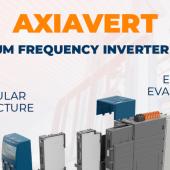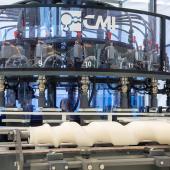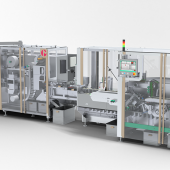Networked is better
PRODOTTI AND STRATEGIES The Omron’s Sysmac platform includes a wide and optimised range of devices integrable in EtherCAT, which enables the automatic, integrated, speedy and accurate control of all machine functions.
EtherCAT is the speediest emerging network for machine automation. Omron has chosen it as a “means” to complement its wide range of motion controllers, servo drives, inverters, vision systems, remote I/O devices, and its recently introduced fiber-optic sensors. Based on Ethernet, EtherCAT is rapid, precise and very efficient in data transmission and the EtherCAT integratable Omron devices have been designed to meet the most stringent flutter immunity requirements.
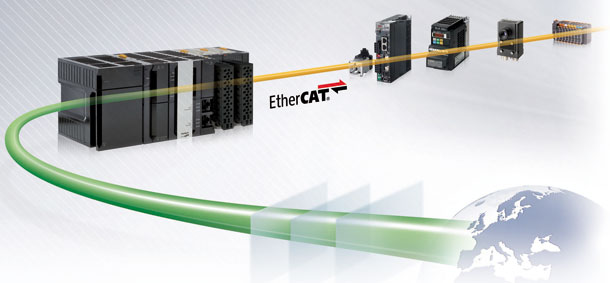
|
EtherCAT, what it is and what it does EtherCAT is an industrial Ethernet network: The EtherCAT message is contained in the data section of the IEEE 802.3 of the Ethernet frame and travels at a speed of 100 Mbps in full-duplex mode. The network uses communication standard Ethernet 100BASE-TX in a very efficient way on standard shielded Ethernet cables and connectors without any need for network switches. It also has great flexibility: thanks to two EtherCAT ports on all devices, a linear network can be created without additional switches; you can also use EtherCAT “leads” to build star and tree topologies to reduce the amount of cables. Easy to configure, with automatic assignment of the node address, it provides a highly accurate synchronization using a mechanism of distributed timers: the EtherCAT slave node measures the time difference between the incoming and outgoing frames (timestamp); thanks to this information, the master is able to accurately determine the propagation delay for each single slave, ensuring the synchronism between devices with flutter and jitter lower than 1 μs. Lastly, the exchange of data takes place “on the fly” in that the slave devices extract and/or insert the data in the selfsame communication stage. |
NJ Series Machine Controller. fulcrum of the new Sysmac platform, is an integrated controller that ensures speed, flexibility and scalability of soft PC based architectures, without compromising the reliability and sturdiness that is expected from traditional Omron PLCs. Its main features are: cycle time from 16 axes/500 μs; motion control from 4 to 64 axes; integrated EtherNet/IP and EtherCAT ports; up to 192 EtherCAT slaves (64 axes), standard IEC 61131-3 programming; certified PLC open function blocks for motion control; linear and circular interpolation; linear axis control, CAM electronic reduction and synchronization; cEC, cULus, NK and LR compliant.
The new controller is the most compact in its class, including an SD card slot and USB port; the cooling system is fanless; in addition, the new system is robust and reliable due to a single event log that monitors CPU, remote I/O devices and networks. With regard to the motion control, it has single-axis and interpolated axis movements, 32 axes/cycle time of 1 ms, electronic cams and synchronization.
The NJ machine controller integrates the PLC logic and motion, allowing the synchronous control of all network devices and works with most of the modules of the CJ-series PLCs. The hardware architecture is based on the new Intel CPUs. EtherNet/IP is the standard network that enables both connection to other controllers, to HMI/SCADA and to IT systems and system programming.
The Accurax G5 servo system. It enables the creation of more accurate, speedy, compact and safe machines. Main features: compact servo drives with EtherCAT connectivity; 2 kHz frequency response; charge vibration suppression function; integrated safety complying with all applicable regulations; advanced tuning algorithms (Anti Shake, feed-forward torque, monitoring of disturbances); a wide range of roto and linear servomotors
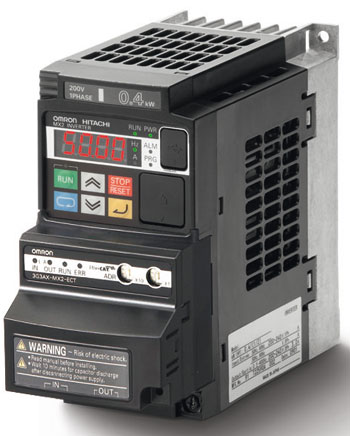 MX2 Inverter. Ideal for smooth control of high inertia loads or for the control of rapid cyclic loads, it fits perfectly in the automation platform Sysmac through EtherCAT connectivity. Its distinctive features are the open-loop torque control, ideal for applications with low and medium levels of torque; with 200% starting torque proximity of 0 (0.5 Hz), the double rating ND 120%/1 min and HD 150%/1 min; power range (up to 15 kW); the possibility of controlling IM and PM motors.
MX2 Inverter. Ideal for smooth control of high inertia loads or for the control of rapid cyclic loads, it fits perfectly in the automation platform Sysmac through EtherCAT connectivity. Its distinctive features are the open-loop torque control, ideal for applications with low and medium levels of torque; with 200% starting torque proximity of 0 (0.5 Hz), the double rating ND 120%/1 min and HD 150%/1 min; power range (up to 15 kW); the possibility of controlling IM and PM motors.
FQ-M Vision Sensor. Designed specifically for pick & place, thanks to its integrated EtherCAT, can be configured and monitored using Sysmac Studio the software and the dedicated software “tools”.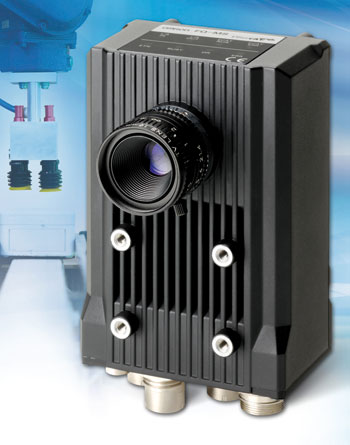
The sensors in this series are compact, with camera, image processing and all in one connectivity, they are fast and have an incremental encoder input that allows you to perform accurate and simple calibrations to independently manage the queue of objects to be picked up.
The standard C pitch objects allow you to choose the field of view and working distance required. The setup and configuration is intuitive and guided by icons, with function and trend and recording function. FQ-M processes up to 5,000 pieces/min with a rotation of 360°, ensuring stable detection even in changing light conditions.
Distributed I/Os. These are divided into two families: SmartSlice - which includes up to 64 I/O modules per station, spring terminals, hot swappable with resetting - and GX, that consists of units of digital and analog I/Os and and encoders, removable I/O terminal, manual and automatic setting of the addresses.
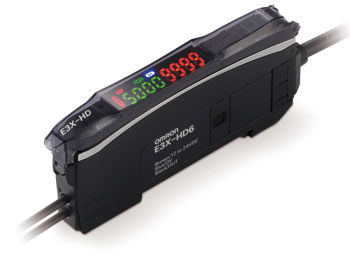 E3X-HD fiber optic sensors. Easy to install and to use via simplified self-study, the new amplifiers are used in a wide range of industrial applications, first and foremost packaging, even in harsh environments with limited space.
E3X-HD fiber optic sensors. Easy to install and to use via simplified self-study, the new amplifiers are used in a wide range of industrial applications, first and foremost packaging, even in harsh environments with limited space.
The light emission and threshold levels are set in one step, simply by pressing a button: once with the object to be detected and once without; also, the same button (usable even with gloves) is used for almost all the setup operations, thus eliminating menus.
The E3X-HD utilize the latest Giga Ray II technology that employs a LED light source, supplemented by a control of the dynamic threshold. These sources are 1.5 times more efficient than traditional LED sources, ensuring broader detection distances, even in difficult conditions.
Dynamic control of the threshold automatically compensates for light levels in the sensor due to the accumulation of dirt and dust, mechanical vibration or natural aging of the light source: the sensor always operates at its optimum threshold point, without need for manual adjustment or maintenance.











